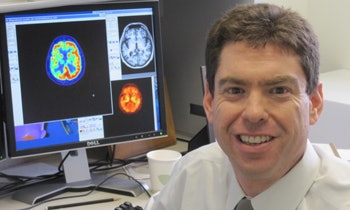
Over the next five to six years, researchers, clinicians, patients, and a host of nonprofit organizations from across the U.S. will collaborate to tackle a few of the nation's most vexing and complex health issues via the Imaging Dementia -- Evidence for Amyloid Scanning (IDEAS) study of Alzheimer's disease, dementia, and cognitive impairment.
The $100 million, groundbreaking IDEAS study will, among a series of goals, evaluate the clinical utility of amyloid PET imaging to diagnose these debilitating conditions, according to Dr. Gil Rabinovici, an assistant professor of neurology at the University of California, San Francisco (UCSF) Memory and Aging Center.
 Dr. Gil Rabinovici, assistant professor of neurology at the UCSF Memory and Aging Center.
Dr. Gil Rabinovici, assistant professor of neurology at the UCSF Memory and Aging Center."We are in a kind of limbo in the field where our ability to diagnose Alzheimer's disease exceeds our ability to treat it," Rabinovici said. "We are in a stage where we can tell people whether they have amyloid in their brain and that can help us to determine if they suffer from Alzheimer's disease at an early state. But how that exactly translates into benefits for patients, given that the therapies we have now do not have a disease-modifying effect, is really the major question that IDEAS is trying to answer."
Rabinovici will lead the study along with Dr. Bruce Hillner, from the department of internal medicine at Virginia Commonwealth University, and Dr. Barry Siegel, chief of the division of nuclear medicine at Washington University in St. Louis.
Origin of IDEAS
The IDEAS initiative was launched in March in response to the 2013 decision by the U.S. Centers for Medicare and Medicaid Services (CMS) to decline coverage for amyloid PET imaging scans for dementia and neurodegenerative disease.
However, as part of the IDEAS trial, the agency will reimburse participating providers for PET scans under the CMS coverage with evidence development (CED) policy, which requires research study participation as a condition of Medicare payment.
The first segment of the study will prospectively recruit 11,050 subjects, with a target of 60% of enrollees with mild cognitive impairment (MCI) and 40% with dementia. The primary objective is to see to what degree amyloid PET imaging can change a patient's treatment plan within 90 days, taking into consideration Alzheimer's or other drug therapies and/or counseling. The MCI and dementia groups will be evaluated separately.
The second phase of the study will assess the efficacy of amyloid PET on major medical outcomes at 12 months, with the addition of 7,438 subjects, bringing total participants to 18,488 subjects.
Because dementia is associated with increased mortality and shorter survival after hospitalizations, researchers will look at whether amyloid PET can achieve at least a 10% annual reduction in amyloid-positive patients being admitted to hospitals and/or visiting emergency rooms.
According to one 2014 study, people with dementia were significantly more likely to seek hospital admission (26.7%) or visit an emergency room (34.5%), compared with similarly elderly patients with no cognitive issues (18.7% and 25.4%, respectively). The study also found that two-thirds of those admissions were preventable (Health Affairs, April 2014, Vol. 33:4, pp. 683-690).
Ultimately, IDEAS researchers hope to be able to predict patients' health track, direct them and their families toward strategies to manage comorbidities, and create a care plan to better protect patients based on their cognitive condition.
Available agents
Three companies currently manufacture and supply amyloid PET imaging agents to assess patients for dementia and Alzheimer's disease: Eli Lilly's florbetapir (Amyvid), GE Healthcare's flutemetamol F-18 injection (Vizamyl), and Piramal Imaging's florbetaben F-18 (Neuraceq).
The trio is expected to contribute a total of $19 million toward the IDEAS initiative. The Medical Imaging and Technology Alliance (MITA) is working with the companies to soon seal the final agreements on what and how much each supplier will donate.
"We are estimating that the cost of the study on the PET scans will be about $20 million," Rabinovici said. "I would say that the vast majority of that will be funded through the manufacturers."
In parallel with the funding, IDEAS supporters have been developing a network to reach out to academic sites and clinical practices that have participated in Alzheimer's-related trials in the past and have been successful in recruiting people.
A website is now up and operational as part of phase I with some basic information about the study's protocol and is collecting email addresses from people who want to be on the distribution list.
Applications for clinical dementia sites and PET sites to participate in IDEAS will be available online soon, Rabinovici said.
"We are looking at hundreds of sites across the country, somewhere between 200 and 300 -- and maybe more than that -- when it does all said and done," he added. "We are also piloting the case report forms, educational materials, and all the things we will need when we are operational."
Additional contributors
The Alzheimer's Association also is contributing $1 million to IDEAS and additional expertise to advance the detection and diagnosis of Alzheimer's and dementia, according to James Hendrix, PhD, director of global science initiatives.
 James Hendrix, PhD, director of global science initiatives at the Alzheimer's Association.
James Hendrix, PhD, director of global science initiatives at the Alzheimer's Association."We were saddened to see CMS's decision not to reimburse for amyloid PET imaging, but we were encouraged, because it left the door open with its national coverage development decision [for IDEAS]," Hendrix added. "If we can show that this technology will change patient care, then [CMS] will reconsider that decision on reimbursement."
The American College of Radiology (ACR) will be the primary manager of the study in terms of the logistics and actual "boots on the ground," Hendrix said, while the Alzheimer's Association will tap into "our chapter networks to try to help get the word out about the study and try to contact dementia experts in our communities."
One of the major challenges, he believes, is enrolling subjects who fit the study's criteria.
"Essentially, it is for people who have an unclear diagnosis of their cognitive issues," Hendrix said. "It is not for someone who has a clear and obvious Alzheimer's or dementia. This is for those people who have unclear or unsure diagnosis."
Another prerequisite is that prospective enrollees be eligible for Medicare, because CMS is funding part of the study. People with private insurance and younger individuals who may have concerns about the early onset of Alzheimer's are ineligible.
Other exclusion criteria include patients with a life expectancy of less than 24 months, individuals in a skilled nursing facility, and those with cancer that requires active therapy (excluding melanoma). In addition, if knowledge of their amyloid status will cause psychological harm or adversely affect patients or their families, those individuals also would be excluded.
"We're trying in our recruitment strategies to reach out more to physicians and PET centers, because they will refer the proper patients to us," Hendrix said. "It will be the dementia experts who will make the assessments, if they are not quite sure why this particular person is having this issue."
Promising results
Certainly, there has been very encouraging research in recent years on the value of amyloid PET imaging to diagnose Alzheimer's disease.
At the 2015 annual meeting of the Society of Nuclear Medicine and Molecular Imaging (SNMMI), researchers from the University of California, Los Angeles (UCLA) found that an amyloid PET scan acquired within a month of an inconclusive conventional FDG-PET exam provided a clearer diagnosis for patients with an Alzheimer's-like pattern of reduced brain metabolism. It also offered earlier, more effective treatment and a better chance to preserve cognitive function.
MRI also has been valuable in helping to detect Alzheimer's disease and dementia. Rabinovici sees both modalities working in tandem to advance future discoveries.
"MRI tells you where the problem is in the brain, but it does not tell you what is causing the problem," he said. "That is for molecular imaging with PET, where you can directly detect protein deposits that basically defined the disease pathologically, which is incredibly important."
In addition, previous longitudinal studies also have found imaging biomarkers that can help stratify the risk of Alzheimer's disease, dementia progression, or decline in cognitively normal or mildly impaired people.
"For example, if we base Alzheimer's disease on brain atrophy on an MRI scan or the presence of amyloid in a PET scan, it might turn out that these people are not declining very much, if we follow them over time," Rabinovici said. "People who show evidence of both a positive amyloid biomarker and evidence of neuro degeneration, like atrophy on an MRI scan, are really at imminent risk of declining."
Whether simultaneous PET/MRI can contribute to the field will depend, in part, on overcoming some technical hurdles.
"I think there are still questions about PET/MRI, especially the PET side in terms of attenuation correction," Rabinovici said. "But assuming all those are solvable problems, the simultaneous acquisition of PET and MRI data might be a very efficient way to assess the brain's risk for Alzheimer's disease. From an imaging analysis point of view, there is not a clear advantage to doing [PET and MRI] simultaneously, but from an efficiency and patient burden point of view, certainly getting both done in one session would potentially be advantageous."
In the meantime, Rabinovici and his colleagues have the ongoing task of keeping IDEAS moving forward.
"This is our first attempt to really study the clinical utility of molecular biomarkers in a real-world setting on a very large scale in the Alzheimer's field and the dementia field," he said. "Hopefully, we are doing a lot of the legwork for future studies, as other biomarkers, such as tau PET, come online and more are developed for potential clinical use."




















